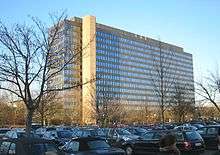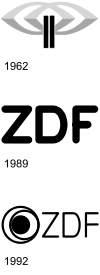ZDF
| Zweites Deutsches Fernsehen | |
|---|---|
 | |
| Launched | 1 April 1963 |
| Owned by | the States of Germany |
| Picture format |
16:9 576i (SDTV) 720p50 (HDTV 1080p50 (HDTV) |
| Audience share | 12.5% (2015, dwdl.de[1]) |
| Slogan | Mit dem Zweiten sieht man besser. With the Second one sees better. (wordplay) |
| Country | Germany |
| Broadcast area |
National; also distributed in: Austria Luxembourg Switzerland Liechtenstein Slovenia Belgium Italy Netherlands Denmark Kosovo |
| Headquarters | Mainz, Germany |
| Replaced | ARD 2 (1961–1963) |
| Sister channel(s) |
ZDFneo ZDFinfo |
| Website |
www |
Availability | |
| Terrestrial | |
| DVB-T | Channel 2 |
| Satellite | |
| Astra 19.2°E (Europe) |
11.953 GHz Horizontal SR: 27500 FEC: 3/4 SID: 28006 Video PID: 110 Audio PID: 120 Stereo, 125 Dolby Digital |
| Astra 19.2°E (DVB-S2 HDTV) (Europe) |
11.362 GHz Horizontal SR: 22000 FEC: 2/3 SID: 11110 Video PID: 6110 Audio PID: 6120 Stereo, 6122 Dolby Digital |
| Hot Bird (Europe, Middle East & North Africa) |
11.054 GHz Horizontal SR: 27500 FEC: 5/6 SID: 8011 Video PID: 570 Audio PID: 571 |
| Cable | |
| Kabel Deutschland | Yes (SD and HD) |
| Cablecom (Switzerland) |
Yes (SD and HD) SD – Channel 006 (digital CH-D) |
| Naxoo (Switzerland) | Channel 154 |
| Ziggo (Netherlands) | Channel 55 (SD/HD) |
| YouSee (Denmark) | Channel 52 |
| Streaming media | |
| ZDF.de | Watch live (Germany only) |
| FilmOn | Watch live |
| Horizon Go |
Horizon.tv (Netherlands only) Horizon.tv (Germany only) Horizon.tv (Switzerland only) |
Zweites Deutsches Fernsehen (German pronunciation: [ˌtsvaɪ̯təs ˌdɔʏ̯tʃəs ˈfɛɐ̯nzeːən]; English: Second German Television), usually shortened to ZDF, stylized as 2DF since 2001, is a German public-service television broadcaster based in Mainz, Rhineland-Palatinate. It is run as an independent nonprofit institution, which was founded by all federal states of Germany (Bundesländer). ZDF is financed by television licence fees and advertising revenues.[2]
The broadcaster is well known for its famous programmes heute, a newscast established in 1963, and Wetten, dass..? an entertainment show premiered in 1981, and ended in 2014.[3] Thomas Bellut, ZDF's director general, was elected by the ZDF Television Council in 2011.[3]
History

ZDF was founded in 1961 by interstate agreement, after the West German federal government's plan to set up a TV channel controlled by the federal government caused uproar. West Germany's constitution stipulated that regulation of culture and media was a compentency of the federal states (Bundesländer). The station began broadcasting from Eschborn near Frankfurt am Main on 1 April 1963, with a speech by the first director general (Intendant), Dr. Karl Holzamer. The channel broadcast its first programme in colour in 1967. In 1974, ZDF moved its base of operations to Mainz-Lerchenberg, after briefly being located in Wiesbaden. In 1960, the German postal service began constructing a transmitter chain for a second television network. This new network was to be broadcast on the UHF spectrum which required new reception equipment. For older receivers, a converter was sold for about 80 DM (about $20 in 1961 dollars[4] ($159 today)). As with the earlier ARD television network, the location of the transmitters was carefully planned to ensure the entire country would be able to receive the programming. To test the transmitters and encourage the public to purchase UHF receivers, the federal government allowed the ARD network to create a temporary secondary channel, ARD 2, which was broadcast daily from 8 to 10 p.m. ARD 2 began broadcasting on 1 May 1961 in the transmission area of Hessischer Rundfunk and a month later expanded nationwide.
Interstate agreement (Staatsvertrag)
Under the government of Konrad Adenauer, the Interior Ministry was to establish a federal TV network, Deutschland-Fernsehen ("Germany-TV"), to compete with the ARD. The SPD-led states of Hamburg, Bremen, Lower Saxony, and Hesse appealed to the Constitutional Court, which on 28 February 1961 in the First Broadcasting Judgment blocked the plan, declaring that all broadcasting powers belonged to the states. In March 1961, the states decided to establish, independently of existing institutions, a central nonprofit public television network. On 6 June 1961, the state premiers signed at a premiers' conference in Stuttgart the interstate agreement on the "establishment of the public institution Second German Television". On 1 December 1961, though not all states had ratified the agreement, it went into force in the states that had done so (Baden-Württemberg, North Rhine-Westphalia, Rhineland-Palatinate). The last state, Bavaria, filed the instrument of ratification on 9 July 1962.
Finances
ZDF is financed by a license fee of €17.98 per month, payable by all households in Germany. ZDF shares the income with ARD and Deutschlandradio. The fees are not collected directly by ZDF, but by the Beitragsservice, a common organization of the ARD member broadcasters, ZDF, and Deutschlandradio. ZDF also has income from sponsorships and programming and advertising sales.
Logos

Transmission and reception
Terrestrial
As ZDF is a channel, not a network, the channel is broadcast throughout Germany, with no regional variations or affiliates, using a number of signal repeaters. ZDF transmitters broadcast a digital signal. Analog signals were gradually phased out, a process which lasted from 2002 to 2008.[5] ZDF does not run any transmitters itself. Throughout the analogue days, all ZDF transmitters were run by the Deutsche Bundespost which was later privatised as Deutsche Telekom's subsidiary T-Systems Media Broadcast. (This is in contrast to the other public German broadcaster, ARD, which owns its main transmitters.) ZDF was not previously allowed to use ARD's transmitters. ZDF has used both ARD and Telekom transmitters since changes to the law in the 1990s, and since the digital switchover.
Cable
ZDF has also been relayed by cable since the days of the first cable pilot projects.
Satellite
The first Europe-wide satellite broadcast via Astra 1C began in August 1993 during the Internationale Funkausstellung Berlin (IFA – "International Broadcasting Exhibition") in Berlin. In the same decade, these new technologies were used to enable digital broadcasting of ZDF. Today, ZDF is available free-to-air throughout Europe on Astra 19.2°E and Hot Bird (13°E).
Other ZDF channels
ZDF operates two digital channels: ZDFneo (aimed at 18-45 year olds) and ZDFinfo (documentaries). Both are transmitted in SD and HD. A commercial subsidiary called ZDF Enterprises GmbH manages programme sales, acquisitions, international coproductions, and a growing number of important activities in new media. ZDF also operates various channels in cooperation with other networks:KI.KA, Arte, 3sat, and Phoenix
Design
ZDF's animated station-identity mascots, the Mainzelmännchen (a play on the words "Mainz" and "Heinzelmännchen"), created by Wolf Gerlach in 1963, quickly became popular and are still shown between commercials.[6] In 1976, Otl Aicher, a graphic designer, created ZDF's corporate design. A new design for ZDF was created by Lee Hunt in February 2000.
Administration
Director General
Administratively, ZDF is headed by a director general (Intendant), who is elected by the ZDF Television Council, the composition of which is in turn determined by "societally relevant groups" named in the ZDF Treaty.
Directors General since the start of ZDF:
- 1963–1977: Karl Holzamer
- 1977–1982: Karl-Günther von Hase
- 1982–2002: Dieter Stolte
- 2002–2012: Markus Schächter
- 2012–present: Thomas Bellut
Supervising board
The supervising board supervises the work of the intendant. They pay special attention to the budget. The supervising board has 14 members:
- Five representatives of the federal states
- One representative of the federal republic of Germany
- Eight independent members (not allowed to work for the government or other public entities)
Television Board
The Television Board supervises ZDF and authorizes the budget. They also elect the Director General. The board has 77 members:
- Sixteen representatives of the states of Germany
- Three representative of the federal republic of Germany
- Twelve representatives of the parties
- Two representatives of the Protestant churches
- Two representatives of the Catholic Church
- One representative of the Central Council of Jews in Germany
- Forty-one members chosen by the representatives mentioned above
Membership
ZDF became a full member of the European Broadcasting Union in 1963. It also has numerous individual cooperation agreements with broadcasters around the world. ZDF is a supporter of the Hybrid Broadcast Broadband TV initiative (a consortium of broadcasting and internet industry companies including SES, OpenTV, and Institut für Rundfunktechnik) which promotes the establishment of an open European standard for hybrid set-top boxes for the reception of broadcast TV and broadband multimedia applications with a single user interface.
Programmes
ZDF's own programmes
- Aktenzeichen XY … ungelöst
- Borgia (Borgia: Faith and Fear), co-producers CANAL+ (France) and others
- The Bridge (2011), co-producers Sveriges Television and DR
- Dance Academy (2010)
- Der Kommissar (cancelled)
- Derrick (cancelled after a 24-year run)
- Die Deutschen
- Die größten Musical Hits (The Greatest Musical Hits)
- Disco
- Ein Fall für Zwei
- Jack Holborn (miniseries for Christmas 1982)
- Kultnacht
- Lafer! Lichter! Lecker! (2006–2010)
- Markus Lanz (2008–2010)
- Maybrit Illner, a political talkshow
- Mino (1986 Christmas miniseries)
- heute (newscast)
- heute-show (comedy)
- Nicht nachmachen!
- Rockpop
- Rock Pop Music Hall (cancelled)
- The Old Fox (Der Alte)
- Wetten, dass..?
- ZDF-Magazin (1969–1988)
- Soko Leipzig
- Soko Köln
- Soko Stuttgart
- Notruf Hafenkante
- Soko Wismar
- Kripo Holstein
- Soko Wien
- Soko 5113
Shown on ZDF
- Alfred J. Kwak
- The Bold and the Beautiful (Reich & Schön, January 2002 - 4 June 2011)
- Dog City
- Fraggle Rock (Die Fraggles)
- In Plain Sight (on ZDFneo)
- Ku'damm 56
- New Tricks
- Star Trek: The Next Generation (Raumschiff Enterprise: Das nächste Jahrhundert)
- Veronica Mars
- The Young and the Restless (Schatten der Leidenschaft)
References
- ↑ "Sat.1 legt zu, Das Erste mit Tief, RTL und ZDF vorn". dwdl.de. Retrieved 2016-01-01.
- ↑ "European Benchmarking: Public Service Broadcasters in the Digital Era" (PDF). Circom Regional. May 2002. p. 46. Retrieved 19 July 2009.
- 1 2 "ZDF Unternehmen".
- ↑ "Historical US Dollars to German Marks currency conversion". UC Santa Barbara History Department. Retrieved 24 October 2013.
- ↑ "ZDF.com".
- ↑ "ZDF Mainzelmännchen".
External links
| Wikimedia Commons has media related to ZDF. |
- Main website (German)
- ZDF website in English (English)
- ZDF at the Internet Movie Database
Coordinates: 49°57′52″N 8°12′29″E / 49.96444°N 8.20806°E